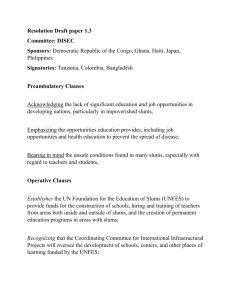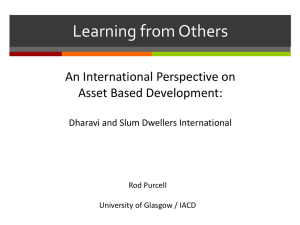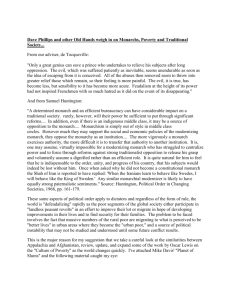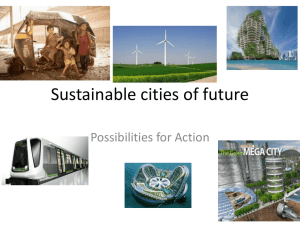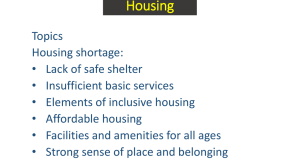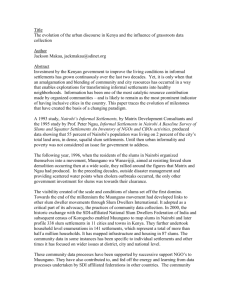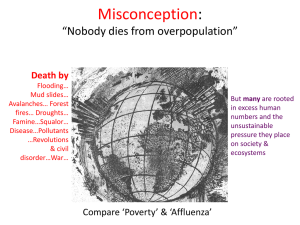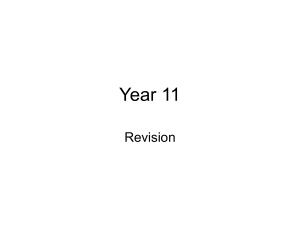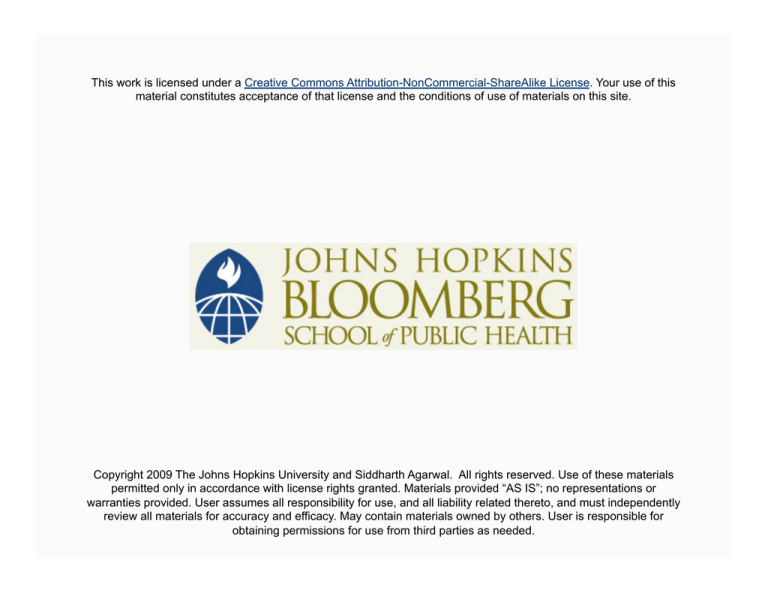
This work is licensed under a Creative Commons Attribution-NonCommercial-ShareAlike License. Your use of this
material constitutes acceptance of that license and the conditions of use of materials on this site.
Copyright 2009 The Johns Hopkins University and Siddharth Agarwal. All rights reserved. Use of these materials
permitted only in accordance with license rights granted. Materials provided “AS IS”; no representations or
warranties provided. User assumes all responsibility for use, and all liability related thereto, and must independently
review all materials for accuracy and efficacy. May contain materials owned by others. User is responsible for
obtaining permissions for use from third parties as needed.
Urban Health in India: A Case Study
Dr. Siddharth Agarwal
Urban Health Resource Centre, India
Major Topics
India’s urban health scenario
Challenges in improving health of the urban poor
Indore program case study
Agra program case study
3
Section A
India’s Urban Scene
India’s Urban Health Scenario
Urbanization, urban poverty, and vulnerability
Health care system in India: an overview
Rural-urban and intra-urban health disparities
Characteristics of slum populations
5
Questions for Discussion
Is urbanization uniform across cities?
Where do the poor stay in cities?
There are many large hospitals in cities
- Is there still a need of new health care investments?
Urban health indicators are generally better than rural health
indicators
-
Then what is the rationale of advocating for urban health?
6
Urbanization
Photo by Lee LeFever. Creative Commons By-NC.
7
World Population, 1804–2054 (In Billions)
Source: Population Reference Bureau. (2003); United Nations. World population in 2300 (medium scenario).
8
Urban Population
Source: United Nations. World Urbanization Prospects. The 1999 revision (for 2000).
9
Maximum Urban Growth in Poor Countries
Source: United Nations. World Urbanization Prospects. The 1999 revision (for 2000).
10
Urbanization Trends in Asia
In Asia urban population is expected to increase from 1.55 billion to
2 billion by 2016
Asia (excluding Japan) is projected to become 50% urban by 2025
(from the current 38%)
The urban population growth in Asia is 2.3 compared to 0.14 in
Europe
Number of million+ cities likely to increase from 194 to 288 by 2015
Source: United Nations. World Urbanization Prospects. The 2003 revision.
11
Urban Growth and Poverty in India
Urban growth and poverty in India
- Urban population—328 million
Projections for 2007 by Technical Group on Population
Projections
- India is expected to be approximately 40% urban (550 million)
by 2026
Census, 2001 population, projections, 2001–2026
- 2-3-4-5 phenomenon of population growth
Chatterjee, G. (2002). Consensus versus confrontation:
(UNHABITAT).
- Urban poor estimated at 80.74–100 million
National Population Policy, 2000
- Estimated annual births among urban poor: 2 million
Based on CBR 19.1 for urban population and 100 million
urban poor population
Source: Planning Commission. Poverty estimates for 2004–05, based on URP.
12
Greater Population in Small and Medium-Sized Cities
13
Urban Scenario in EAG States
EAG (Empowered Action Group, Government of India, 2001)
identified eight states that lag behind on demographic and health
indicators
- These are UP, MP, Rajasthan, Bihar, Orissa, Jharkhand,
Chhatisgarh, and Uttaranchal
Source: Data from Census 2001 and NSSO 55th round, 1999–2000.
14
Key Messages
Urbanization is a fast growing phenomenon
Maximum urban population growth is concentrated in less developed
countries
India’s future growth will largely be concentrated in urban areas,
and growth will be fastest in slums
Most growth and population will be in small and medium-sized cities
Mega-cities continue to grow and and have importance beyond their
proportion of urban population
15
Section B
India’s Urban Health Scenario
Urban-Rural Contrasts
Health care has been largely rural biased
Rural–urban and intra-urban health disparities exist
Characteristics of slum population
17
Health Care System in Rural India
Organized health care system largely limited to rural areas
18
Health Care System in Urban Areas
Health posts and urban family welfare centers (UFWCs) provide
primary health care for 50,000 population as government norm
State government in smaller cities and municipal bodies in large
cities manage health services
ICDS provides nutrition and health services—in urban areas its
coverage is far less (18.1%) than in rural areas (69.1%)
- Based on 523 urban ICDS projects and 285 urban population
ICDS operates through Anganwadi Centre (AWC); one for every 1,000
population.
AWCs provide both preschool education and health and nutrition
counseling
19
Poor Child Health and Survival
Health conditions of urban poor are similar to or worse than rural
population and far worse than urban averages
Source: (2003). Re-analysis of NFHS 2 (1998–99) by standard of living index. EHP.
20
Childhood Under-Nutrition
Source: (2003). Re-analysis of NFHS 2 (1998–99) by standard of living index. EHP.
21
Poor Access to Health Services
In India, nearly 1 million babies are born every year in slum homes
Source: (2003). Re-analysis of NFHS 2 (1998–99) by standard of living index. EHP.
22
Conditions Worse in Less Developed States
Madhya Pradesh
23
Poor Environmental Health Conditions
About two thirds (65.9%) urban poor households do not have a
toilet
Photos by Siddharth Agarwal.
24
Poor Environment
Among urban high-income group, almost all households have toilets
Photo by Siddharth Agarwal.
25
Water Supply Situation
Thirty-eight percent of urban poor households do not receive piped
water at home as compared to 18% in urban rich households
Photos by Siddharth Agarwal.
26
Substantial Economic Contribution of Urban Poor
Almost 90% of urban poor are involved in urban informal sector
Photo by Steve Evans. Creative Commons BY.
Source: USAID. (2002). Making cities work, India urban profile.
27
Yet Urban Poor Are Underserved
Urban sector contributes 60% of
gross domestic product (GDP)
- Chaudhary, O. (2004,
September 3). New vistas
in financing for
development of real state.
FICCI National Real Estate
Summit.
Photo by Siddharth Agarwal.
Informal sector’s contribution
to non-agricultural GDP is 45%
- International Labour Office.
(2002). Women and men in
informal economy.
28
Key Messages
Health care system is inadequate in urban areas and highly rural
focused
Urban poor are far underserved by health and nutrition services as
compared to rural areas
Urban health indicator averages mask the inequities suffered by the
urban poor
Availability of safe drinking water and toilets to urban poor is
unsatisfactory
A multitude of factors affect vulnerability of slum populations
29
Section C
Challenges in Improving Health of Urban Poor in India
Challenges
Improving health of the urban poor
- Programmatic challenges
- Opportunities in urban areas
- UHRC’s response
31
Issue for Discussion
What from your experience are the main challenges in improving
health of the urban poor?
32
Challenge #1: Invisible Slums
According to NSSO 58th Round (2002), 49.4% of slums are nonnotified in India
780 slums (total)
452 listed slums
(population 820,139)
328 unlisted
slums
(population
510,397)
33
Large Proportion of Slums Are Uncounted, Invisible
Listed vs. unlisted slums
- Agra (215 vs. 178)
- Dehradun (78 vs. 28)
- Bally (75 vs. 45)
- Jamshedpur (84 vs. 77)
Besides unlisted slum settlements, urban poor also include
pavement dwellers, population residing in construction sites, brick
and lime kilns, fringes of the city, floating population, etc.
34
Challenge #2: Inadequate Services
Inadequate primary health and nutrition services
- There is one UFWC/HP for about 0.23 million urban population1
against the government norm of 1 for 50,000 population
- Absenteeism, inconvenient timings, lack of medicines, and
apathy at public facilities discourages the poor to use them
- About half (48%) the slum population is not covered by ICDS, a
key maternal and child nutrition and health program in India2
- Greater focus and investment on curative services
Note: 1Based on an urban population of 285 million (2001 Census) and 1,197 government urban primary health facilities
(Department of Family Welfare, MoHFW, GOI); 2Based on 100 million urban poor population (NPP, 2000) and 523 ICDS
projects.
35
Challenge #3: Weak Services
Weak coordination, capacity; scarce program experience
- Weak coordination among various stakeholders
- Weak capacity among government and NGO managers on urban
health
- Very few examples of coordinated, planned slum health
programs in most states
36
Challenge #4: Weak Referral
Weak referral mechanisms
- Low access of health services to the poor
- High usage of hospitals for minor ailments
- Weak referral linkages from community and primary facilities
- Lack of health insurance mechanisms for the poor
- High usage of public referral hospitals by middle and higher
income segments
37
Challenge #5: Weak Demand
Weak demand among urban poor
- Low awareness about services and provisions
- Low awareness about healthy behaviors
- Weak community organization and social cohesion
- Weak negotiation capacity
- Low level of trust in public sector services owing to irregularity
and low quality
38
Challenge #6: Struggle for Subsistence
Struggle for subsistence and weak family support
- Pressing need to resume wage earning
- Lack of family support to mother/care giver
- Sub-optimal household behaviors
- Preoccupied with struggle of livelihood
- Constant threat of eviction
39
Challenge #7: Multi-Dimensional Vulnerability
Factors and situations resulting in health vulnerability in slums
- Irregular employment, low access to fair credit
- Poor access to water and sanitation services, overcrowding,
poor housing, and insecure land tenure
- Lack of access to ICDS and primary health care services
- Unlisted slums often outside the purview of civic and health
services
Source: Taneja, S., and Agarwal, S. (2004). Situational analysis for guiding USAID/EHP India’s
technical assistance efforts in Indore, MP.
40
Challenge #7: Multi-Dimensional Vulnerability
Factors and situations resulting in health vulnerability in slums
- Irregular employment, low access to fair credit
- Poor access to water and sanitation services, overcrowding,
poor housing, and insecure land tenure
- Lack of access to ICDS and primary health care services
- Unlisted slums often outside the purview of civic and health
services
- Temporary and recent migrants often denied access to health
services, difficult to track for follow-up health services
- High prevalence of diarrhea, fever, and cough among children
-
-
Lack of organized community collective efforts in slums
Widespread alcoholism, substance abuse, gender inequity, poor
educational status
Source: Taneja, S., and Agarwal, S. (2004). Situational analysis for guiding USAID/EHP India’s
technical assistance efforts in Indore, MP.
41
Summary of Challenges
Policy gaps
- Urban health remained a low
priority with greater focus on
rural areas
- Lack of credible data for urban
poor related planning
- Urban slums face social
exclusion, illegality, and many
overlooked by official
enumeration systems
Supply, service convergence gaps
- Urban poor grossly underserved
and having low access to
health services
- Greater focus on curative
services resulting in neglect of
primary and preventive health
care
- Existing services underutilized
by the urban poor
- Lack of coordination among
multiple stakeholders
42
Summary of Challenges
Low demand and struggle on
multiple levels
- Weak knowledge and social
capital among slum dwellers—
sense of resignation
- Urban poor struggle against
multidimensional vulnerability
Gap in capacity and program
experience
- Weak capacity among
government and NGO managers
on urban health
- Very few examples of
coordinated, planned slum
health programs in most states
43
Opportunities in Urban Areas
Growing recognition of the problem among government agencies
- Growing interest among donors
- Large presence of experienced and interested NGOs in urban
areas
- Increased financial allocation and investment in slum
development and health programs
- Growing body of urban-poor-specific research and data
44
UHRC’s Response
Influencing national and state policy and program and
other stakeholders
City TA cum
demonstration and
learning programs
Indore, Agra
Meerut, Delhi
Source: Urban Health Resource Centre, New Delhi.
National- and
state-level
technical
assistance
UP, MP, Bihar,
Uttarakhand,
Jharkhand,
Rajasthan,
Maharashtra
Research,
knowledge
management, and
advocacy
UH conference
Symposia
Publications, reports
Web site
45
Section D
Indore Urban Health Program
Urban Population Indore
Growing urban poor population in Indore
- Population: 1.8 million (2001 census)
- Decadal growth rate (1991–2001): 47%
- Estimated slum population: 0.6 million
- Number of slums: 539 (314 not part of official slum lists)
47
Urban Health Situation in Indore
Inadequate health care service for the urban poor
- Seventeen primary health care facilities, many functioning suboptimally
- Poor access of urban poor to health care
- Heavy workload on limited outreach staff insufficient
interaction with community, irregular outreach sessions
Low demand and sub-optimal behaviors among the urban poor
Improper coordination among different service providers
48
Issue for Discussion
How would you approach the situation in Indore to ensure health
care for the urban poor?
49
How Did Program Directions Evolve?
Program planning
- Stakeholder consultations
- Situation analysis
- Health vulnerability assessment of slums
50
Key Findings
NGO-CBO potential
Multiplicity of stakeholders
Public sector technical support needs
Priority technical areas
Sustainability is key
Insufficient community demand for services
Underserved slums identified and targeted
51
Program Approaches in Indore
NGO-CBO partnership approach
Ward coordination model
Technical support to public sector
52
Assessment of Slums in the City
Listing of
slums ensuring
identification
of all poverty
pockets
Developing
vulnerability
criteria
through slum
visits and
discussions
Slum-based
data
collection
Consolidation of
data and
categorization
of slums;
Mapping
Triangulation of
results for
vulnerability,
slum location
and hidden
areas
Understanding the local context through needs assessment and
situation analysis
Identification, assessment, and plotting of slums in the city
53
Plotting Slums, Facilities
City map with slums, facilities
plotted an important planning
and monitoring tool
54
Identifying and Targeting Underserved Slums
539 slums
Pop: 600,000
157 most
underserved
slums
79 slums
NGO-CBO partnership
Pop: 150,000
225 slums
(official list)
Indore population: 1,800,000
55
Program Approaches in Indore
Approach 1
- NGO-CBO partnership approach
Enhancing demand, supply, capacity, and fostering linkage
Approach 2
- Ward coordination approach
Convergence among stakeholders to optimize resources
and improve reach
56
Approach 1
Linking slum communities with public and private providers
57
Building Sustainable Institutions
Building sustainable institutions in
underserved urban communities
NGOs with support from technical
agency (UHRC, formerly EHP
India) undertake periodic program
review and implement
appropriate improvement
measures as identified during
review
58
Cluster Coordination Team
Nine cluster coordination teams
Also called lead CBOs; 7–9 slums per cluster
Seven registered as voluntary organizations
Plan and negotiate for regular health services
-
Referral linkages and coordination with service providers
(health, water, sanitation, etc.)
-
Monitoring, supervision, and support to basti CBOs in health
activities as necessary
59
Basti-Level CBOs
Ninety community groups of 7–12 members, including dais across
75 bastis (slums), ensure reach of services and community-based
monitoring by …
- Counseling slum families on healthy behaviors
- Identifying unreached families and ensuring access for them
- Supporting regular MCH camps in slums
60
Community at Work
Registration of beneficiaries—
identifying left-outs and dropouts
Linkage with the auxiliary nurse-midwife for vaccine administration
Information and community motivation—women arrive for
immunization day
61
Improved Health Indicators in Indore Slums
62
Program Outcome: Delivery-Related Practices
63
Place of Delivery
64
Approach 2
Multi-stakeholder ward coordination approach
Health dept.
Municipal corporation
(zonal office)
Elected representatives
Charitable organizations
ICDS
NGOs & CBOs
Local resources
(local clubs, schools)
DUDA*
Total coverage: 70,000 slum population in two wards in Indore
*District Urban Development Authority
65
Present Status
Expanded reach of services to 48 slums in two wards covering more
than 70,000 underserved populations
Reorganization of catchment areas of existing health centers
improved access for left-out/newly identified slums
Private sector involvement: private schools and private doctors have
made their premises available for outreach camps
Approach replicated from September 2005 in Ward 7, where
monthly camps cover about 35,000 vulnerable population across 24
slums
66
Improved Health Indicators in Ward 5 of Indore
67
Lessons Learned
Situation analysis (participatory mapping, transect and group
discussions) helps identify underserved slums, priority needs and
local resources
NGO-CBO consortia has been an effective strategy in enabling the
partners to utilize complementary skills and capacities
Slum-level institutional and individual capacity building is important
for sustainability and stabilizing community-level institutions and
strengthening linkage with government program
68
Lessons Learned
Cluster coordination teams comprising of slum leaders evolved as a
potent institutional mechanism for slum health (and development)
programs
Partnership and coordination among multiple stakeholders facilitate
the use of resources from varied sources and eliminate duplication
of efforts
A combination of the two approaches is useful for sustaining
improved reach of services to urban poor
69
Section E
Agra Urban Health Program—A Case Study
Urban Poverty Situation in Agra
Growing urban poor population in Agra
- Population: 1.33 million (2001 census); 2004 estimate: 1.6
million
- Decadal growth rate (1991–2001): 42%
- Estimated slum population: 0.8 million
Total slums: 393
- Officially listed: 215 (population 0.5 million)
- Unlisted: 178 (population 0.3 million)
Of 393 slums, 183 are most vulnerable, 173 moderately vulnerable,
and 37 less vulnerable
Weak coordination among different service providers
71
Urban Health Care Situation in Agra
Public sector health facilities
Fifteen primary-level health centers, large parts of city unserved
Outreach services weak, irregular, inconvenient timing of primarylevel health facilities
District hospital-1, district women hospital-1, and medical college-1
ICDS centers: 95 ICDS centers in the city, 43 located in slums
Low access to health care, weak demand and low usage of services
by slum communities; sub-optimal health behaviors
72
Private and NGO Sector
Presence of NGOs, some with health program experience
Two charitable hospitals, many private practitioners, few private
hospitals
Informal sector preferred due to convenient location and flexible
time
73
Issue for Discussion
Based on the needs, service gaps and options, what would you as a
public health program manager do for optimizing public health gains
in Agra slums?
74
Program Approaches
Approach 1
- NGO-managed service delivery and community mobilization
Approach 2
- NGO-facilitated demand generation and service linkage
75
Clearly Define Unserved Areas and Plan Accordingly
Map clearly defined unserved areas and plan accordingly
76
Approach 1
NGO-managed service delivery, community mobilization
- Two such UHCs are operational, covering 53 slums with
approximately 106,252 people
Note: Other organizations, such as Arpana Trust (Delhi), Sumangli Seva Ashram, Shri Sharan Seva Samaja, Lions Club
Trust, and others in Bangalore (as well as several NGOs in Chennai) are involved in similar partnerships
77
Approach 2
NGO-facilitated demand generation and service linkage
Note: Outreach services include treatment of minor illnesses, ANC, immunization, birth spacing, health education; Through
this approach community linkages are being established with two UHCs covering approximately 65,060 population
78
Selection of Slum Link Volunteers
Identification of CLV (community
link volunteer)
Link volunteer
Women from the slum, preferably
married, identified as CLVs through
a participative and transparent
process
79
Role of Community Link Volunteers
Track beneficiaries and monitor coverage, support in organizing
outreach camps
Conduct health behavior promotion activities
Identify special attention households in slums, counsel individual
and family, motivate for behavior change and availing health
services
Support promotion of women’s health groups
Identify and refer cases requiring medical attention to UHC, escort
women to hospitals
80
Formation of Women’s Health Groups
Group formation
Slum-level women’s health groups
formed with help of CLVs and NGOs
from active, interested members of
the slum community, encouraged to
work collectively
81
Role of Women’s Help Groups
Support link volunteer in tracking and monitoring of coverage of key
services
Motivate target women for attending group counseling sessions
Help organizing outreach camps and ensuring presence of target
groups
Linkage with service providers (UHCS)
Collect, manage, utilize community health fund
82
Preliminary Process Level Outcomes
May 2005 to May 2007
83
Process Outcomes
22 regular monthly outreach sessions cover 47 slums with 82,400
population
108 link volunteers in place, each covering 1,500–1,800 population
69 women’s health groups formed in 58 slums
Link volunteers and women’s group members encourage early
adopters to motivate resistant women and support special attention
households
Community health fund: 52 groups across 43 slums have initiated
health fund
84
Process Outcomes
Improved quality of MCH services through NGO partnership
- Improved regularity of service: two new UHCs catering to
106,000 slum population
- More comprehensive ANC and other services
- Improved availability of medicines, e.g., antibiotics, RTI
medicines
Enhanced capacity of NGO partners to generate resources locally
(about 10–15% of grant value)
Improved capacity of women’s health groups to meet health
emergencies at slum level—29 health loans disbursed so far
85
Slum-Level Activities
Dissemination of health messages—
MAS members counseling pregnant women during outreach session
Immunization tracking—identifying left-outs and dropouts through
slum mapping
86
Improving Health Services and Behaviors
CLV and MAS members encourage women for ANC checkups during
outreach camps
Information and community motivation—MAS members singing
health songs
87
Early Lessons
NGOs can effectively complement government’s efforts to …
- Quickly expand health services to unserved areas
- Strengthen outreach services from existing government facilities
Link volunteers and women’s health groups, mobilize slum
communities, and improve linkages with and access to services
88
More Lessons
City map with slums and facilities plotted helps effectively plan new
health centers and outreach services
Intersectoral linkages to address water and sanitation issues are
difficult in weak governance situations like Agra
Multipronged persuasive advocacy required to overcome resistance
to change among government stakeholders
89
With Hope and Confidence
“A small body of determined spirits fired by an unquenchable faith
in their mission, can alter the course of history”
- Mohandas Karamchand Gandhi
Accountable,
effective
urban health
governance
Long lever of …
a) Commitment motivation
b) Knowledge, experience
c) Proximity to problems
d) Accountability, responsibility
Source: Urban Health Resource Centre. www.uhrc.in
Public health
professionals, civil
society, government,
slum communities
90

